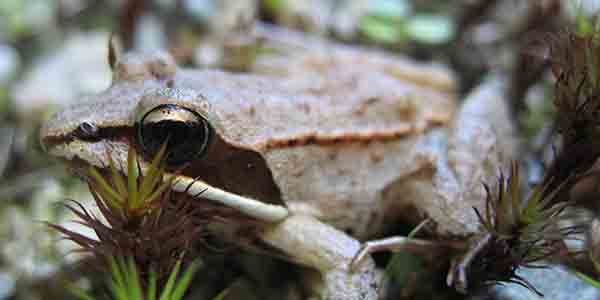Out In The woods
- March 22nd 2024
- Out in the Woods

Wood Frog
Photo: NHPBS
Wood Frogs Emerging from a Frozen State
By Kevin McKeon, Director, Mousam Way Land Trust
The duck-like, barking sounds of the wood frogs calling for their mates are among the first sounds we hear during our early spring walks, especially along the wetland areas of the Rail Trail. Built through Springvale’s damp valley, there are numerous vernal pools along this trail; breeding habitats loved by these early spring singers. When not breeding, wood frogs are found in all types of forests, preferring damp areas like ravines, forested wetlands, swamps, and bogs, while foraging for a variety of insects and small invertebrates, including spiders, beetles, and moth larvae.
Males search for a mate by hugging other frogs until they find one who is round enough to be carrying eggs. As he hugs her, he’ll fertilize her approximately 1,000 eggs as she lays them, often in the deeper sections of the pools and often attached to other egg masses which in turn are attached to vegetation within the pools. Eggs will hatch within 10-30 days, depending on the temperature. The larval stage, known as tadpoles, feed on algae, detritus, and the larvae of other amphibians, taking a little over a month to mature into frogs. Tadpoles die if the pool dries up prior to growing into a frog.
The value of vernal pools is well illustrated by wood frogs’ and other amphibians’ early spring egg laying. Wildlife awakening from their winter dormancy and returning migratory critters are hungry and vernal pools offer a rare, rich, and timely food source. At 2 to 2 3/4” long, wood frogs are identified by a white line above the lip, a dark “robber’s mask” across the eyes and color ranging from brown to rust to shades of green with the ability to change color.
Now, for the amazing wood frog story! It is the only frog species that survives above the Arctic Circle, aided by the rare ability to withstand freezing. As winter approaches, their bodies begin to store both urea and fat. As their bodies begin to freeze, these stored substances convert to a sort of anti-freeze in their cells, protecting the cells from damage otherwise caused by the freezing water. Ice fills the abdominal cavities, encases their internal organs, and forms between layers of skin and muscle. So, ice forms outside their cells, but not inside their cells. Their eyes freeze and turn white. They enter a deep hibernation. Their brains shut down, heart and blood flow stop and freeze solid to a state of suspended animation, becoming dead by conventual definition. Their cells maintain a very limited function but with no communication between them.
Wood frogs emerge from hibernation when an early spring rainfall thaws them. Their hearts start to beat, awakening their brains and their legs begin to move. Their yearly migration from their winter slumber under leaves in the forest to the vernal pools begins in late February and March. They can sometimes be seen swimming under the ice. Watch them come to life (link ).
As global warming continues to lessen snowfall, wood frog survival is likely to suffer, as they become easier prey under thinner snow cover. So, if you happen to espy a seemingly dead frog, leave it be or maybe hide it under a light cover of leaves. Nature will awaken it when the time is right and reward us with the singing of a wondrous woodland amphibian.







